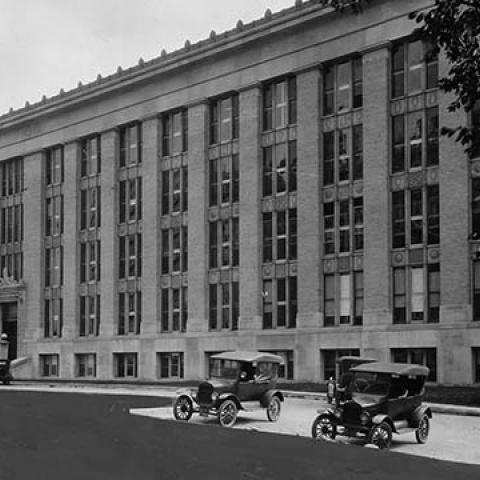A century ago, Western Reserve University's trustee, Samuel Mather, gave $2.5 million to construct a new building marking the School of Medicine's establishment in University Circle from its downtown Cleveland location.
The building was dedicated in October of the next year—in conjunction with the inauguration of Robert E. Vinson—as President of Western Reserve University.
At the time, the building was simply known as the "Medical School."
Today, it is known as the Harland Goff Wood Building—named for the highly distinguished, longtime professor and department head, Dr. Harland Wood.
While the building has grown and expanded over the century, it is still a central hub of the school's research programs. Today, it remains a modern biomedical research building with many of its laboratories operating 24 hours a day, seven days a week.
Over the past 100 years of the school's 180-year history, there have been many discoveries in the Wood Building laboratories that have changed medicine and improved health across the globe.
Learn more about the many Nobel Laureates who have trained, taught and researched at the School.
A century of knowledge and discovery
In 1946, the Dean of the School of Medicine, Joseph Wearn, recruited Harland Wood to "resurrect a virtually moribund biochemistry department."
Wood, not yet 40 at the time, was already held in high regard.
A decade earlier, in 1935, as a graduate student, he made a groundbreaking discovery—carbon dioxide is utilized by bacteria and animals, including humans.
Prior to this discovery, it was widely believed that CO2 fixation was exclusive to plants and certain bacteria.
This pioneering work challenged scientific thinking—and ultimately led to a better understanding of the metabolic processes common to almost all living tissues.
Wood continued to be a trailblazer in the use of radioisotopes in cell biology—paving the way for new breakthroughs in the field. His research findings also had significant implications for the treatment of metabolic disorders, including diabetes.
During Wood's lifetime, his contributions to science and scholarship were widely recognized—earning him a place in the US National Academy of Sciences. He was awarded the National Medal of Science—the highest honor for scientific achievement.
Many regarded him as one of the most outstanding biochemists who never received a Nobel Prize.
Pivotal contributions
Wood was pivotal in establishing the Department of Biochemistry and was its inaugural director.
Today, the Wood Building remains home to Biochemistry— on its fourth and fifth floors. The department has a rich history of biomedical research, with several areas of focus and a national reputation.
Wood was also a key figure in the Medical School's 1952 curriculum revision—which was hugely influential and widely adopted by other medical schools. His leadership was critical in ensuring the success of the revision.
While working in the building that would once bear his name, Wood provided valuable counsel and expertise while serving on the President's Science Advisory Committee – during the administrations of Lyndon Johnson and Richard Nixon.
Mandatory retirement ages for faculty did not slow him down. Though he "retired" as University Professor Emeritus in 1978, the university's trustees allowed him to continue his work.
He remained an active and productive researcher—publishing nearly 100 more papers.
The day before he died in 1991, he had an article accepted for publication. He also held three NIH grants and still led a team of 15 associates in his lab.
A year after his passing, the university's Board of Trustees voted unanimously to change the name of this building to honor Wood—not in recognition of a monetary gift—but for his exceptional contributions as an educator and scientist.


